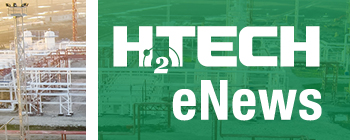News
Why bigger means better: Next-gen virtual pipelines crucial to accelerate H2 adoption
Anticipated increases in demand and supply for hydrogen (H2) means safe, efficient and cost-effective transport solutions are fundamental to the entire ecosystem, according to gas storage specialists, Luxfer Gas Cylinders.
Its latest innovation - a next-generation virtual gas pipeline solution - brings fresh efficiency and utility, which is unprecedented in the UK hydrogen industry.
The solution is called the G-Stor® Hydrosphere. This range of high-capacity multi-element gas containers (MEGCs) can move more than one tonne of H2 in one mobile unit.

Keith Croysdale, Business Development Manager at Luxfer Gas Cylinders Europe, explains: “Projected global demand for clean H2 by 2030 is estimated at 12 metric tpy–18 metric MMtpy based on current pipeline of publicly announced projects. Transporting this gas - safely and efficiently - to where it’s needed will be vital to drive the whole ecosystem. With suitable pipeline infrastructure far from ready and alternative storage methods such as liquid and solid state not yet viable in many scenarios, compressed gas remains the most practical and reliable solution for H2 transport today.”
The award-winning G-Stor® Hydrosphere MEGCs are the latest development from Luxfer Gas Cylinders’ pioneering alternative fuel experts. The range has already been selected to supply cutting-edge H2 projects including HyHaul, the UK’s first H2 mobility corridor, through partnership with specialist bulk liquid and gas transport company, Reynolds Logistics.
These next-generation MEGCs offer larger gas capacity, meaning:
- Fewer fills
- Fewer trips
- Lower OPEX
- Fewer total MEGCs needed
- Reduced carbon intensity.
The virtual pipeline offering is the latest in a string of world and UK firsts from the alternative fuel team Luxfer Gas Cylinders, including:
- The HydroFLEX UK-first H2-powered train – a high-profile, complex, multi-supplier project launched ahead of COP26. Luxfer developed a bespoke H2 system to the customer’s specification.
- The world’s first H2 Luxfer Gas Cylinders worked with bus partners to make H2-powered buses a reality, with Aberdeen’s world-first H2 fleet of 15 double deckers featuring bespoke systems from Luxfer.
- The first commercially available H2-powered refuse trucks. In development for two years, Luxfer worked with refuse truck manufacturers in Europe to design, fit and support 20 vehicles.
- The world’s first commercially produced H2 A multi-million-pound project integrating H2 technology into 60 trucks marked the first such green fleet in history. Each featured a 190-kilowatt (kW) fuel cell comprised of seven high-pressure tanks holding around 35 kg of H2, and providing a long-distance range of more than 400 km before refueling.
Keith Croysdale has taken a leading role in the UK and Europe’s H2 journey through his role as executive of the UK Hydrogen Energy Association. As an experienced engineer, he now works with leading organizations in green H2 production and distribution.

